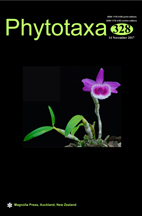Abstract
A new species of Magnolia, from the Lagunas de Montebello National Park, in the central highlands of Chiapas, Mexico, is described and illustrated. Magnolia montebelloensis belongs to section Magnolia; it differs from M. poasana in its smaller habit, densely pubescent terminal twig internodes, stipules and spathaceous bracts, shorter peduncular internodes and more numerous stamens. A key, an ecological and a conservation assessment of the eight Chiapan species of Magnoliaceae are included. Magnolia montebelloensis grows in montane rain forest and is contrasted with other Chiapan Magnolia species regarding their climate and vegetation preferences. It was assessed as critically endangered (CR) according to IUCN B1ab(ii,
iii) and B2ab(iii) criteria. Half of Magnolia species in Chiapas occur in protected natural areas, and thus immediate action is required to protect the other four species, M. faustinomirandae, M. mayae, M. sharpii and M. zamudioi. Seven out of the eight Magnolia species (88%) are not found in ex-situ collections despite being endangered or critically endangered.

